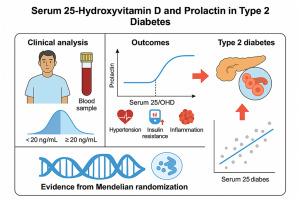A nonlinear, causal link between serum 25-hydroxyvitamin D and prolactin in type 2 diabetes: Evidence from clinical and Mendelian randomization analyses
IF 2.7
引用次数: 0
Abstract
Background
Type 2 diabetes mellitus is increasingly prevalent and often accompanied by vitamin D insufficiency. Prolactin, once considered solely lactogenic, has emerged as a metabolic regulator, yet its relationship with vitamin D in T2DM remains unclear.
Methods
We conducted a cross-sectional study of 221 male T2DM patients aged 25–75 years recruited between January 2022 and December 2024. Serum 25-hydroxyvitamin D (25(OH)D) and prolactin were measured, defining vitamin D sufficiency as ≥ 20 ng/mL. Associations were evaluated using group comparisons, Spearman correlation and multivariable regression adjusting for confounders. Restricted cubic splines assessed nonlinearity and thresholds. Causality was examined via Mendelian randomization employing 227 25(OH)D-associated variants.
Results
Vitamin D deficiency affected 59.7 % of participants. Median prolactin levels were higher in vitamin D-sufficient than in deficient patients. Serum 25(OH)D correlated positively with prolactin and remained significant after adjustment. Spline analysis suggested a nonlinear relationship with an inflection of 18.48 ng/mL: below this threshold prolactin decreased as 25(OH)D increased, whereas above it prolactin rose steeply. Mendelian randomization provided evidence for a causal association: the inverse variance weighted estimate was non-significant, but MR-Egger and weighted median analyses indicated a significant link without pleiotropy or heterogeneity.
Conclusion
These findings demonstrate a nonlinear, threshold-dependent association between vitamin D status and prolactin in male T2DM. Levels of 25(OH)D at 18.48 ng/mL were associated with suppressed prolactin, while sufficient concentrations enhanced prolactin, suggesting that maintaining adequate vitamin D may modulate prolactin and benefit metabolic outcomes. Further research is warranted to validate these observations.

2型糖尿病患者血清25-羟基维生素D和催乳素之间的非线性因果关系:来自临床和孟德尔随机分析的证据
背景2型糖尿病越来越普遍,且常伴有维生素D不足。催乳素,曾经被认为是唯一的乳源性,已经成为一种代谢调节剂,但它与维生素D在T2DM中的关系尚不清楚。方法:我们对2022年1月至2024年12月招募的221例25-75岁男性T2DM患者进行了横断面研究。测定血清25-羟基维生素D (25(OH)D)和催乳素,将维生素D充足度定义为≥20 ng/mL。使用组比较、Spearman相关和多变量回归校正混杂因素来评估相关性。限制三次样条评估非线性和阈值。通过采用227个25(OH) d相关变异的孟德尔随机化来检验因果关系。结果维生素D缺乏影响了59.7%的参与者。维生素d充足患者的泌乳素水平中位数高于维生素d缺乏患者。血清25(OH)D与催乳素呈正相关,调整后仍显著。样条分析表明,在18.48 ng/mL的浓度下,催乳素与25(OH)D升高呈非线性关系,低于该阈值时催乳素随25(OH)D升高而下降,高于该阈值时催乳素急剧上升。孟德尔随机化为因果关系提供了证据:反向方差加权估计不显著,但MR-Egger和加权中位数分析表明,无多效性或异质性的显著联系。结论:维生素D水平与男性T2DM患者泌乳素之间存在非线性、阈值依赖性关联。18.48 ng/mL 25(OH)D水平与泌乳素抑制相关,而足够浓度的25(OH)D可增强泌乳素,这表明维持足够的维生素D可调节泌乳素并有益于代谢结果。需要进一步的研究来验证这些观察结果。
本文章由计算机程序翻译,如有差异,请以英文原文为准。
求助全文
约1分钟内获得全文
求助全文
来源期刊

Metabolism open
Agricultural and Biological Sciences (General), Endocrinology, Endocrinology, Diabetes and Metabolism
自引率
0.00%
发文量
0
审稿时长
40 days
 求助内容:
求助内容: 应助结果提醒方式:
应助结果提醒方式:


